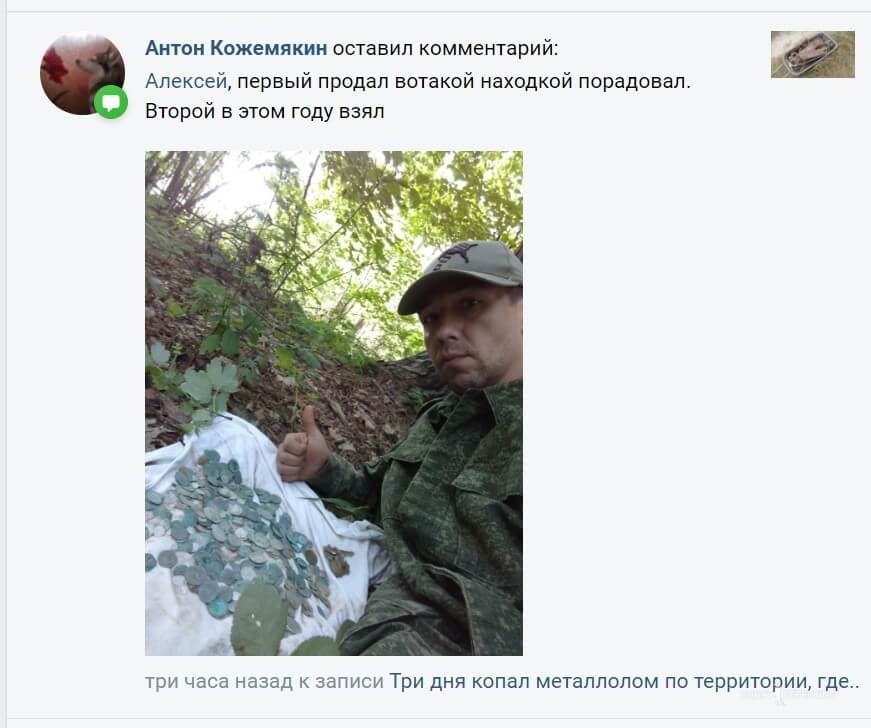Social networks are full of notes about rare finds and treasures. Why did they stop catching these braggarts?
Cop loves silence. The main rule of any treasure hunter. However, not everyone follows this rule and not always. And, if you look closely at the statistics of the appearance of photographs of treasures and other rare finds on social networks, you can see that in the last year and a half the number of such notes has increased sharply. Moreover, it comes to the point that individuals are no longer even embarrassed or afraid to show their personality in an embrace with the found treasure.
Just like in this photo. I won’t go into detail about whether this is a real treasure or just another decree for self-affirmation. I will say that, in my opinion, this is 99.99% real treasure.

I’ll write separately about the dementia and courage of such braggarts. And now, I want to systematically analyze the reason that in the last two years administrative and criminal cases against diggers and treasure hunters have virtually completely disappeared from judicial practice. Cases initiated and brought on the basis of identified publications in social networks and specialized public pages.
To make it clear what we are talking about, it is necessary to explain that just some three or four years ago, 99% of all criminal and administrative cases against antiquity diggers and treasure hunters were initiated by investigative authorities on the basis of photos and videos of finds and objects representing objects identified on social networks. historical value.
If you are interested in how it was before, here are links to two notes that I discussed in detail earlier:
Bloggers found treasure and will now pay a fine of half a million rubles
The case of the Yuriev-Polish treasure hunter. What could go wrong? (how to lose 3 million rubles)
And so, let’s move on to describing the causes and consequences of why recently there have been much fewer criminal and administrative cases against antiquity diggers. As you understand, there is not just one reason, there are several of them at once and here are the main ones.

First. Workload of qualified investigators. It is no secret or secret that 90% of all criminal and administrative cases against antique diggers and collectors of archaeological objects that previously came to court were initiated and conducted by employees of the Ministry of Good Deeds. (The term is taken from the TV series “Brigade”) As we understand, for the last year and a half, employees and investigators of this department have been overloaded with more important work related to well-known events. Therefore, they simply have neither the time, nor the desire, nor the vertical order to deal with coins and crosses.
Second. And this is also the case. Most of these are notes where certain individuals boast of treasures, gold, revolvers from bandit caches, and so on. This is the work of the investigators themselves. Typical social phishing. They post photos in places where the target audience lives compactly, maybe someone will take the bait. And, I think, they are biting. They start writing in a personal message that these are your finds, but mine are many times cooler, here’s a photo, and I found it just like that, and a friend also has a Domongol. Further, identifying this individual is not even a matter of technology, but of one request to the VK office
Third. Fraudsters. And here, dear readers, it will be very interesting for you. The topic of scammers always comes to our brother the digger’s heart. According to the information I have, it is scammers who post and publish photos with treasures and other rare antiquities in comments under thematic posts. Moreover, they do this according to all the rules of social engineering, creating the appearance of dialogue. One scammer publishes photos, for example, of a treasure of Peter’s rubles, the second casually and inadvertently asks: “Where is the treasure of deeds?” comes the answer: “I sold and bought an apartment (a car, a yacht, an island in Hawaii)” Well, and then the unobtrusive dialogue itself leads the reader to the fact that… If you have a treasure and you are afraid to show it to anyone and don’t know where it can be safely sold, write to the first person in PM; out of altruistic motives, he will tell you everything for free and give links. Then it’s a matter of technology, they can lead you to a fake site, an analogue of a well-known auction site, with a further offer to send coins for evaluation or immediately for sale, and money after the sale.
Have you thought about it?
Fourth. Changes in legislation. And this is most likely the most objective explanation in our analysis. That's the problem. So that two hundred cases of illegal trafficking of archaeological objects, Article 7.15.1 of the Code of Administrative Offenses of the Russian Federation, are brought before trial, or initiate a criminal case under Art. 243.2 of the Criminal Code of the Russian Federation, you must definitely obtain an expert opinion that the finds depicted in the photo or video are archaeological objects. Precisely an archaeological object. And not a subject of archaeology, not a subject of archaeological value, not a subject corresponding to the subject of archaeology. Precisely, clearly, according to the law “archaeological object” . And, here's the rub. The fact is that there is no expert methodology for identifying and defining an archaeological object. Just as there is not a single certified expert on this topic in our country. No methodology – no experts, no experts – no expert opinion, no expert opinion – no corpus delicti.
Thank you for your attention. If you have read this article up to these lines and you find it interesting, don’t take the trouble to like it and express your opinion in the comments.
